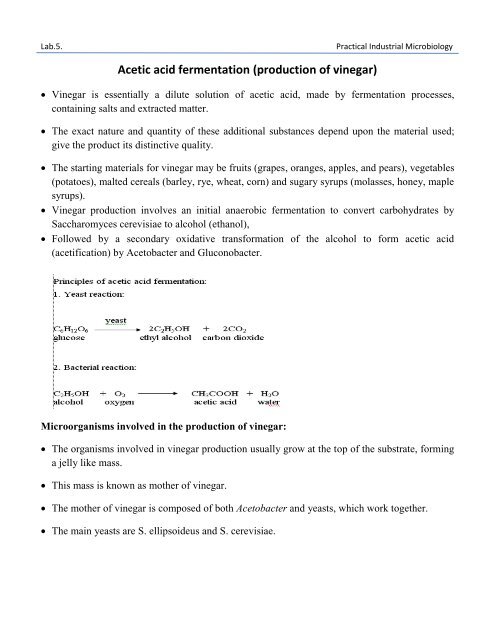Acetic acid fermentation (production of vinegar)
Acetic acid fermentation (production of vinegar)
Acetic acid fermentation (production of vinegar)
You also want an ePaper? Increase the reach of your titles
YUMPU automatically turns print PDFs into web optimized ePapers that Google loves.
Lab.5.<br />
Practical Industrial Microbiology<br />
<strong>Acetic</strong> <strong>acid</strong> <strong>fermentation</strong> (<strong>production</strong> <strong>of</strong> <strong>vinegar</strong>)<br />
Vinegar is essentially a dilute solution <strong>of</strong> acetic <strong>acid</strong>, made by <strong>fermentation</strong> processes,<br />
containing salts and extracted matter.<br />
The exact nature and quantity <strong>of</strong> these additional substances depend upon the material used;<br />
give the product its distinctive quality.<br />
The starting materials for <strong>vinegar</strong> may be fruits (grapes, oranges, apples, and pears), vegetables<br />
(potatoes), malted cereals (barley, rye, wheat, corn) and sugary syrups (molasses, honey, maple<br />
syrups).<br />
Vinegar <strong>production</strong> involves an initial anaerobic <strong>fermentation</strong> to convert carbohydrates by<br />
Saccharomyces cerevisiae to alcohol (ethanol),<br />
Followed by a secondary oxidative transformation <strong>of</strong> the alcohol to form acetic <strong>acid</strong><br />
(acetification) by Acetobacter and Gluconobacter.<br />
Microorganisms involved in the <strong>production</strong> <strong>of</strong> <strong>vinegar</strong>:<br />
The organisms involved in <strong>vinegar</strong> <strong>production</strong> usually grow at the top <strong>of</strong> the substrate, forming<br />
a jelly like mass.<br />
This mass is known as mother <strong>of</strong> <strong>vinegar</strong>.<br />
The mother <strong>of</strong> <strong>vinegar</strong> is composed <strong>of</strong> both Acetobacter and yeasts, which work together.<br />
The main yeasts are S. ellipsoideus and S. cerevisiae.
<strong>Acetic</strong> <strong>acid</strong> bacteria are strictly aerobic, G+ rods, characterized by their ability to carry out a<br />
number <strong>of</strong> oxidations and they can tolerate high concentration <strong>of</strong> <strong>acid</strong>, including A. acetics, A.<br />
xylinum and A. ascendens.<br />
It is important to maintain an <strong>acid</strong>ic environment to suppress the growth <strong>of</strong> undesirable<br />
organisms and to encourage the presence <strong>of</strong> desirable acetic <strong>acid</strong> producing bacteria.<br />
It is common practice to add 10-25% by volume <strong>of</strong> strong <strong>vinegar</strong> to the alcoholic substrate in<br />
order to attain a desirable <strong>fermentation</strong>.<br />
Fermentation method:<br />
1. Quick <strong>vinegar</strong> methods (German method).<br />
2. The Orleans process (French method; slow method).<br />
Procedure:

















